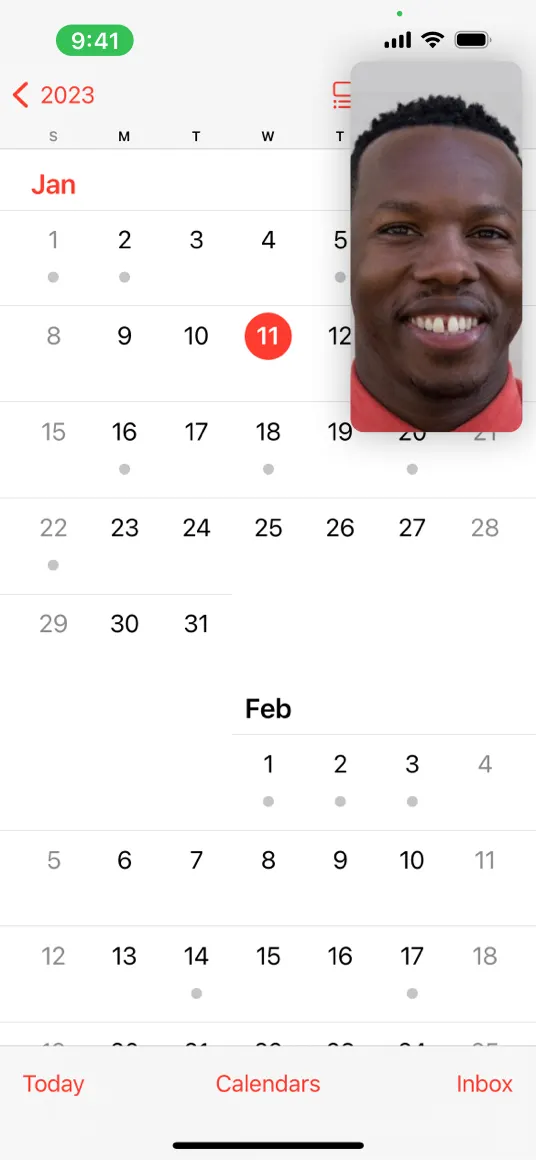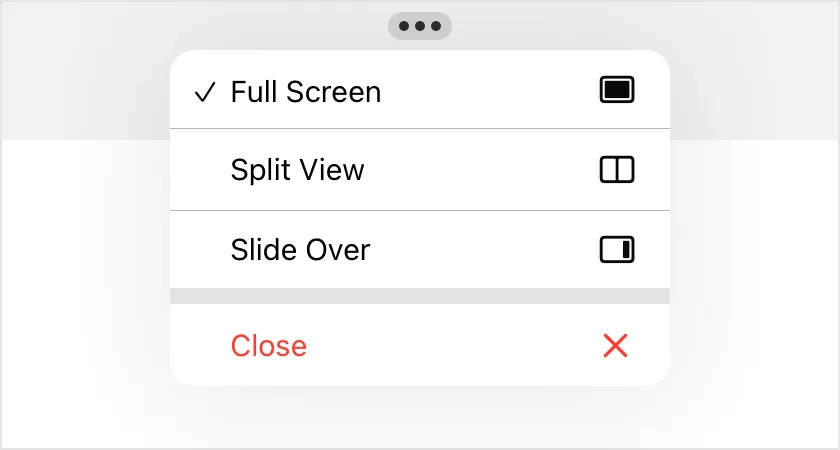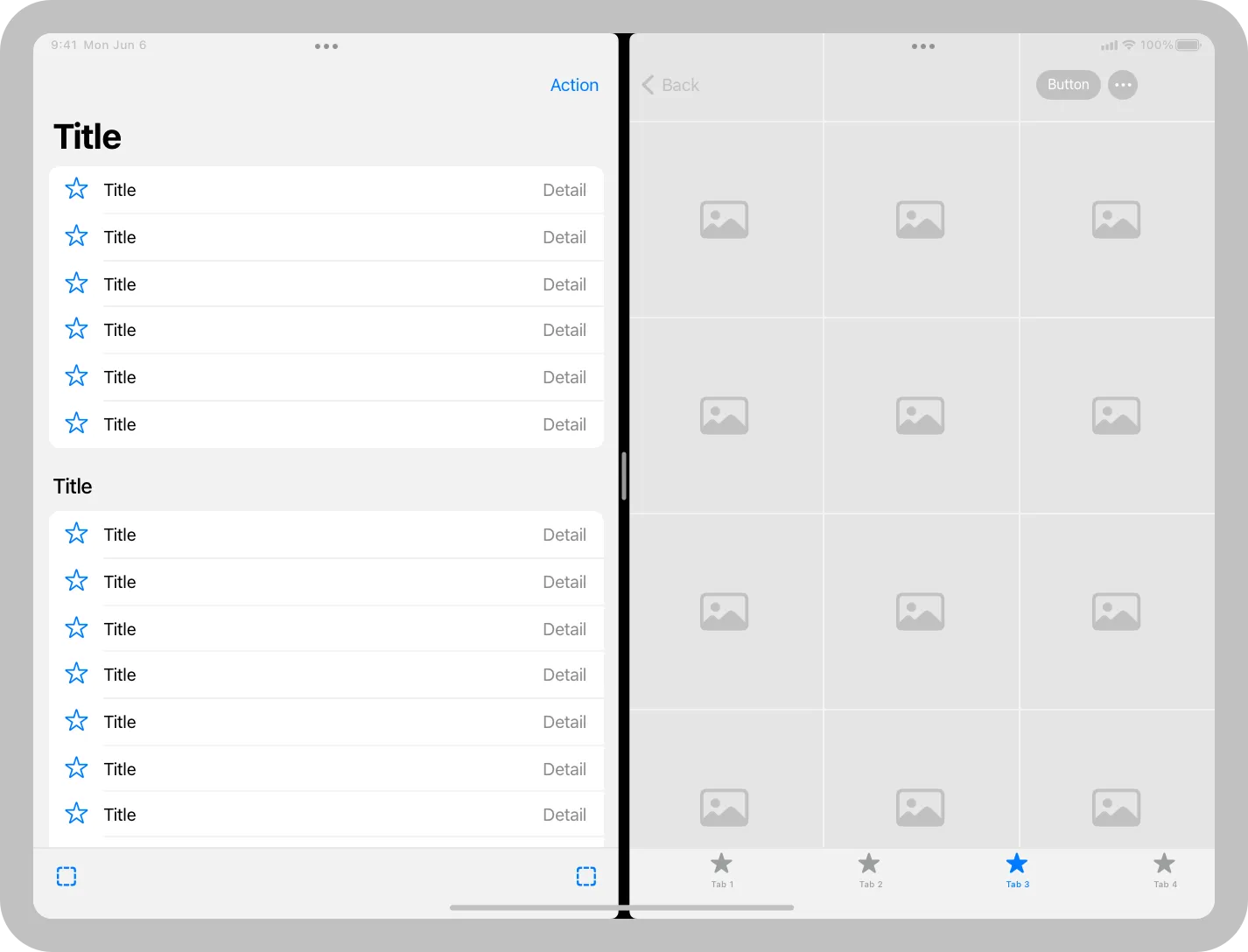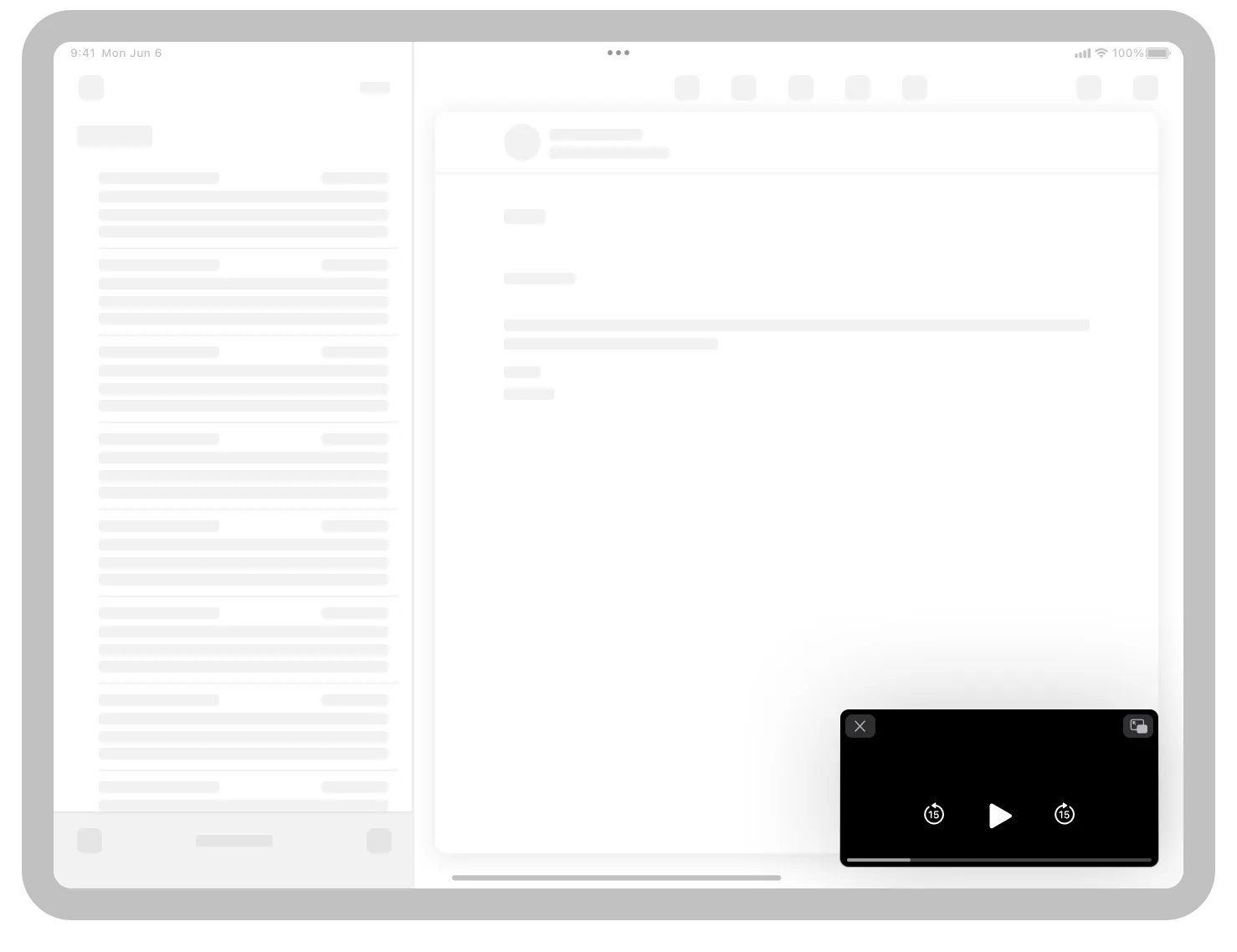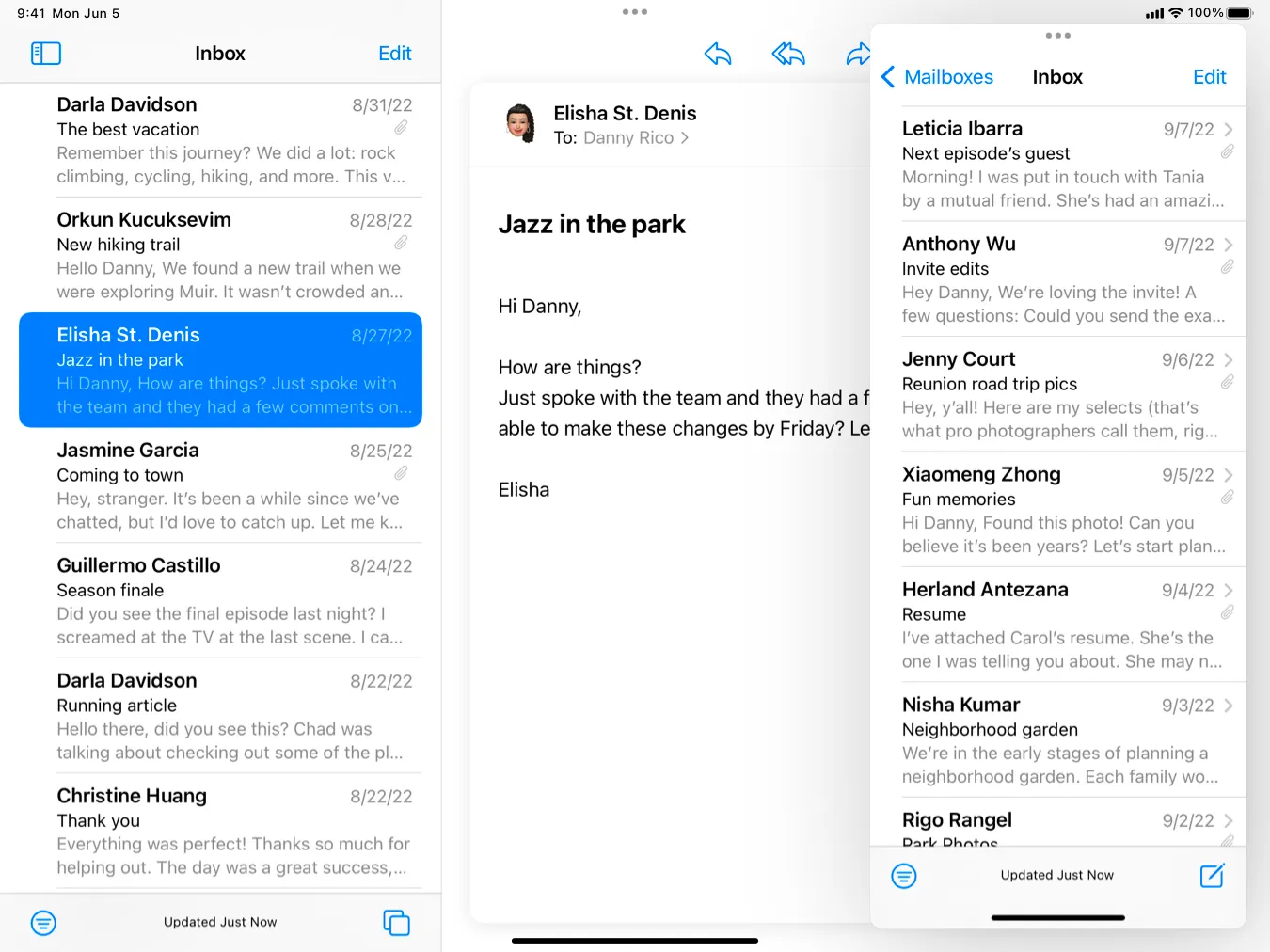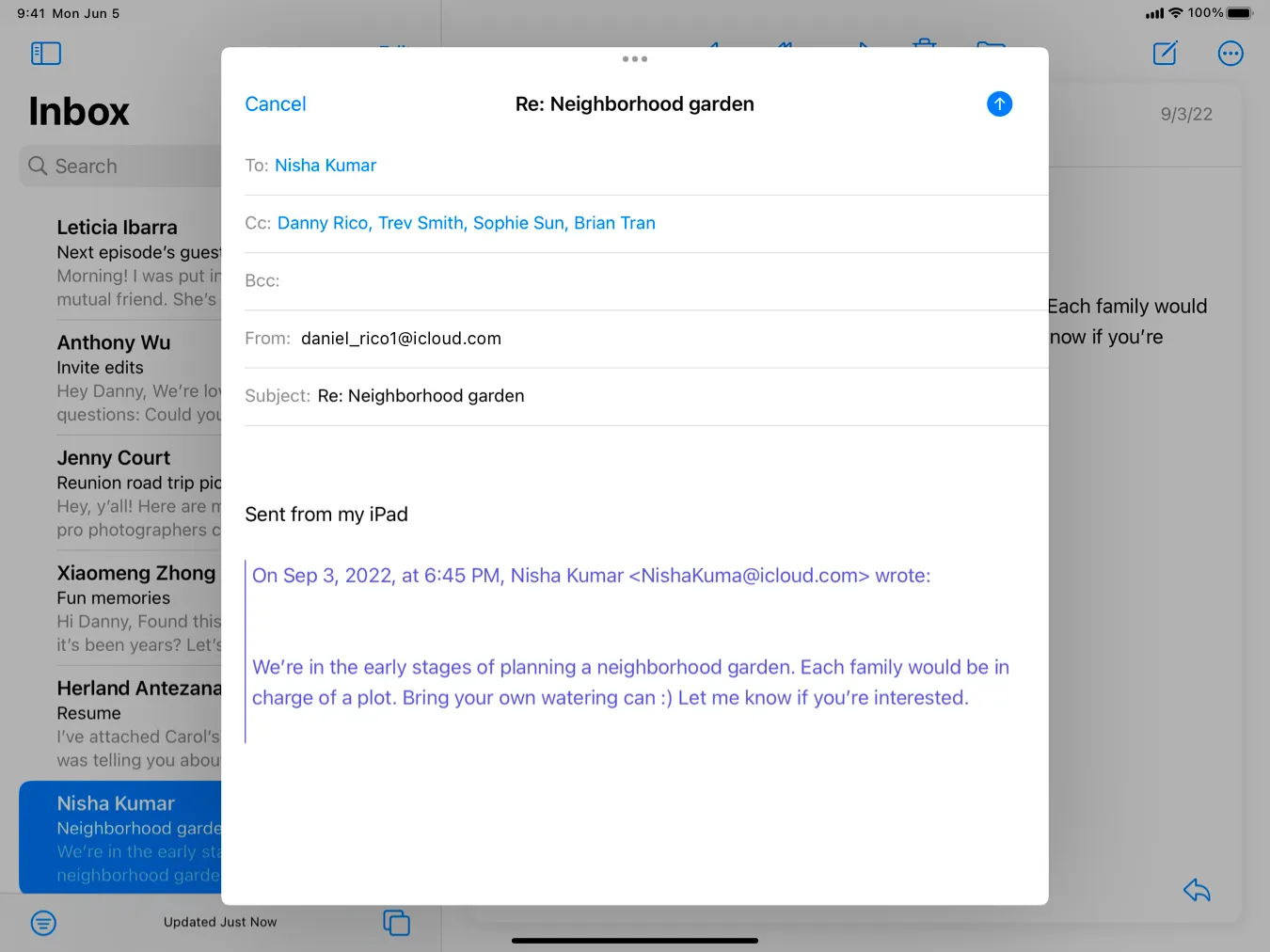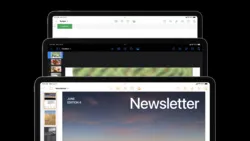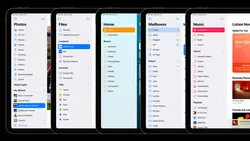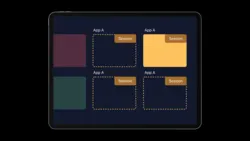Multitasking lets people switch quickly from one app to another, performing tasks in each.
멀티태스킹은 한 앱에서 다른 앱으로 빠르게 전환하여 각각의 작업을 수행할 수 있도록 합니다.
People expect to use multitasking on their devices, and they may think something is wrong if your app doesn’t allow it. With rare exceptions — such as some full-screen–only iPad apps and Apple Vision Pro apps running in a Full Space — every app needs to work well with multitasking.
사용자들은 본인의 기기에서 멀티태스킹을 사용할 수 있기를 원하며, 앱이 멀티태스킹을 지원하지 않는다면 뭔가 이상하다고 생각할 수 있습니다. 풀 스페이스에서 실행되는 iPad 앱이나 Vision Pro 앱과 같은 매우 드문 경우를 제외하고, 모든 앱들은 멀티태스킹을 잘 지원해야 합니다.
In addition to app switching, multitasking can present different experiences on different devices.
추가적으로, 앱 전환 시 멀티태스킹은 다른 기기에서 다른 경험을 제공할 수 있습니다.
On Vision Pro, people can run multiple apps at the same time in the Shared Space, viewing and switching between windows and volumes throughout their space.
Vision Pro 사용자들은 Shared Space에서 여러 앱들을 동시에 실행할 수 있습니다. 이 공간 안에서 윈도우와 볼륨들을 서로 전환할 수 있습니다.
역자 첨언
On iPhone, multitasking lets people use FaceTime or watch a video in Picture in Picture while they also use a different app.
아이폰에서, 멀티태스킹은 사용자들이 다른 앱을 사용하면서도 페이스타임이나 동영상을 PIP(Picture in Picture)에서 볼 수 있도록 합니다.
The app switcher displays all currently open apps.
이 app switcher는 현재 열려있는 모든 앱들을 보여줍니다.
A current FaceTime call can continue while people use another app.
FaceTime 통화는 다른 앱을 사용중일 때도 계속 실행됩니다.
On iPad, people can view and interact with the windows of several different apps at the same time. An individual app can also support multiple open windows, which lets people view and interact with more than one window in the same app at one time.
아이패드에서 사용자들은 여러 앱들의 윈도우를 동시에 보고 사용할 수 있습니다. 개별 앱은 여러 개의 윈도우를 열 수 있도록 지원할 수 있으며, 이를 통해 한 번에 같은 앱 하나 이상의 창을 보고 사용할 수 있습니다.
With multitasking, windows from several apps — like Weather, Maps, and Photos — can be available onscreen at the same time.
멀티태스킹을 사용하면 날씨, 지도, 사진과 같은 여러 앱의 창을 동시에 사용할 수 있습니다.
Calendar lets people open multiple calendar windows at the same time.
달력 앱은 한 번에 여러 창을 열 수 있습니다.
On Apple TV, people can play or browse content while also playing movies or TV shows in Picture in Picture (where supported).
Apple TV에서 사용자들은 PIP(가 지원된다면)에서 영화나 TV 프로그램을 재생하면서 동시에 탐색할 수 있습니다.
On a Mac, multitasking is the default user experience because people typically run more than one app at a time, switching between windows and tasks as they work. When multiple app windows are open, macOS applies drop shadows that make the windows appear layered on the desktop, and applies other visual effects to help people distinguish different window states; for guidance, see macOS window states.
Mac에서는, 사용자들은 일반적으로 한 번에 두 개 이상의 앱을 실행하고 창과 작업 사이를 전환하기 때문에 멀티태스킹이 기본 사용자 경험입니다. 여러 창이 열려있으면, macOS는 윈도우 간에 그림자를 적용해 다른 상태를 구별할 수 있도록 합니다. 지침은 macOS window states를 참조하세요.
→ Mac은 여러 앱을 동시에 사용하므로 멀티태스킹은 기본입니다.
역자 첨언
In contrast, watchOS makes it easy for people to switch between favorite or recently used apps, but people don’t open more than one app at a time on their watch.
반대로, watchOS는 favorite 또는 최근 사용한 앱 간 전환이 쉽지만, 한 번에 두 개 이상의 앱을 열 수는 없습니다.
A great multitasking experience helps people accomplish tasks in multiple apps by instantly pausing the current context when they switch away and seamlessly restoring it when they switch back. Because you don’t know when people will initiate multitasking, your app or game always needs to be prepared to save and restore their context.
훌륭한 멀티태스킹 경험은 앱 전환 시 현재 진행 중인 것을 즉시 중지하고 다시 전환할 때 원활하게 복원해 여러 앱에서 작업을 수행할 수 있도록 도와줍니다. 사람들이 언제 멀티태스킹을 시작할 지 모르기 때문에, 앱이나 게임은 항상 context를 저장하고 복원할 준비를 해야 합니다.
→ 앱이나 게임은 항상 현재 context를 저장하고 복원할 준비를 해야 합니다.
In iOS and iPadOS, pause activities that require people’s attention or active participation when they switch away. If your app is a game or a media-viewing app, for example, make sure people don’t miss anything when they switch to another app. When they switch back, let them continue as if they never left.
iOS나 iPadOS에서, 사람들의 관심이나 참여가 필요한 활동을 일시 중지하세요. 예를 들어, 앱이 게임이거나 미디어를 시청하는 앱이라면, 사람들이 다른 앱으로 전환할 때 아무것도 놓치지 않도록 하세요. 앱으로 다시 돌아왔을 때 마치 떠나지 않았던 것처럼 계속하도록 하세요.
→ 앱을 떠났다가 다시 돌아왔을 때에도 이전 작업을 그대로 이어 할 수 있도록 하세요.
Respond smoothly to audio interruptions. Occasionally, audio from another app or the system itself may interrupt your app’s audio. For example, an incoming phone call or a music playlist initiated by Siri might interrupt your app’s audio. When situations like these occur, people expect your app to respond in the following ways:
오디오 중단에 부드럽게 대응하세요. 때때로, 다른 앱이나 시스템 자체의 오디오가 당신의 앱의 오디오를 방해할 수 있습니다. 예를 들어, 수신 전화나 Siri가 시작한 음악 플레이리스트가 당신의 앱의 오디오를 방해할 수 있습니다. 이와 같은 상황이 발생하면, 사람들은 앱이 다음과 같은 방식으로 반응하기를 원합니다:
•
Pause audio indefinitely for primary audio interruptions, such as playing music, podcasts, or audiobooks.
•
음악, 팟캐스트, 오디오북 재생과 같은 기본 오디오 재생을 위해 오디오를 무기한으로 일시 중지하세요.
•
Temporarily lower the volume or pause the audio for shorter interruptions, such as GPS directional notifications, and resume the original volume or playback when the interruption ends.
•
GPS 방향 알림과 같은 짧은 재생을 위해 일시적으로 볼륨을 낮추거나 오디오를 일시 중지하고, 중단이 끝나면 원래 볼륨으로 되돌리거나 재생을 재개하세요.
Finish user-initiated tasks in the background. When someone starts a task, they expect it to finish even if they switch away from your app. If your app is in the middle of performing a task that doesn’t need additional input, complete it in the background before suspending.
사용자가 시작한 작업은 백그라운드에서 완료하세요. 누군가가 작업을 시작할 때, 앱을 전환하더라도 작업이 완료될 것으로 예상합니다. 앱이 추가 입력이 필요한 작업을 수행하고 있는 것이 아니라면, 일시 중지되기 전에 백그라운드에서 완료하세요.
Use notifications sparingly. Your app can send notifications when it’s suspended or running in the background. If people start an important or time-sensitive task in your app, and then switch away from it, they might appreciate receiving a notification when the task completes so they can switch back to your app and take the next step. In contrast, people don’t generally need to know the moment a routine or secondary task completes. In this scenario, avoid sending an unnecessary notification; instead, let people check on the task when they return to your app. For guidance, see Managing notifications.
알림을 남발하지 마세요. 앱이 백그라운드에서 실행 중이거나, 아예 보류중이더라도 알림을 보낼 수 있습니다. 사용자들이 중요하거나 시간에 구애받는 작업을 실행하다 다른 앱으로 전환했을 때, 작업 완료 알림을 받고 다음 단계로 넘어가기 위해 알림을 받고 싶어할 수도 있습니다. 하지만, 일상적인 작업 또는 보조적인 작업의 완료를 알릴 필요는 없습니다. 불필요한 알림은 지양하고, 앱으로 돌아왔을 때 완료된 작업을 볼 수 있도록 하세요. 지침은 Managing notifications을 참고하세요.
→ 앱이 진행하던 중요한 작업이 완료됐을 때 알림을 보내되, 사소한 작업에 대해서는 자제하세요.
No additional considerations for iOS, macOS, or tvOS. Not supported in watchOS.
iPadOS can present multitasking windows in a variety of configurations, supporting various workflows. The system also provides multitasking controls — which let people switch multitasking configurations — and the app shelf, which lets people access all open windows in an app.
iPadOS는 다양한 방법으로 멀티태스킹 윈도우를 제공할 수 있으며, 다양한 워크플로우를 지원합니다. 사용자들이 멀티태스킹 구성을 바꿀 수 있는 멀티태스킹 컨트롤도 지원하며, app shelf는 앱의 모든 윈도우를 보여줍니다.
→ iPadOS는 다양한 방법으로 멀티태스킹을 지원합니다.
Multitasking controls
App shelf
People can choose one of the following configurations to open multitasking windows on iPad.
사용자들은 멀티태스킹 윈도우를 열기 위해 다음 방법들 중 하나를 선택할 수 있습니다.
•
Slide Over opens a second window in an overlay while the first window continues in full screen. People can change the onscreen location of the Slide Over window, or hide it offscreen and retrieve it later. People can also open multiple windows in Slide Over, where they form a stack.
•
Slide Over는 기존의 창이 전체 화면으로 유지되고, 그 위에 두 번째 창을 엽니다. 사용자들은 이 창을 이동시킬 수 있으며, 화면 밖으로 숨기고 나중에 다시 가져올 수도 있습니다. 또한 Slide Over에서 여러 창을 스택 형식으로 열 수 있습니다.
•
Split View displays two windows side by side, letting people resize the relative areas of the windows and interact with both. While viewing side-by-side windows in Split View, people can also open a third window in Slide Over.
•
Split View는 두 개의 창을 나란히 표시하며, 사용자들은 이 창이 맞닿은 부분을 조절해 양쪽 창의 크기를 동시에 조절할 수 있습니다. 이 상황에서, Slide Over를 사용해 세 번째 창을 여는 것도 가능합니다.
•
Picture in Picture opens a video in a movable, resizable window that floats above the full-screen app.
•
Picture in Picture는 전체 화면 앱 위에 떠서 움직이거나 크기 조절이 가능한 영상을 엽니다.
Slide Over
Split View
Picture in Picture
Note
Apps don’t control multitasking configurations or receive any indication of the ones that people choose.
앱은 멀티태스킹 방법을 제어할 수 없고, 사람들이 어떤 방법을 선택했는지 알 수 없습니다.
To help your iPad app respond correctly when people open it in Split View or Slide Over, make sure it adapts gracefully to different screen sizes. For guidance, see Layout; for developer guidance, see Multitasking on iPad. To learn more about how people use iPad multitasking features, see Use multitasking on your iPad.
아이패드 앱이 Split View나 Slide Over에서도 잘 동작하게 하려면, 다른 화면 크기에도 잘 적용되도록 하세요. 지침은 Layout을, 개발자 지침은 Multitasking on iPad을 참조하세요. iPad 멀티태스킹 기능을 사용자들이 어떻게 사용하는지 보려면 Use multitasking on your iPad를 참조하세요.
Conceptually, iPad apps tend to use two types of windows to provide content:
기본적으로, iPad 앱은 콘텐츠를 제공하기 위해 두 가지 타입의 윈도우를 사용합니다.
•
A primary window presents the app’s full hierarchy, providing access to all of the app’s objects and the actions associated with them. For example, Mail uses a primary window to present all mailboxes and message lists.
•
기본 윈도우는 앱의 전체 계층 구조를 표시해 앱 전체 객체와 거기에 연관된 작업에 대한 액세스를 제공합니다. 예를 들어, Mail 앱은 기본 윈도우를 사용해 모든 메일박스와 메일 리스트를 표시합니다.
•
An auxiliary window presents a specific task or area in the app, often using a modal presentation. Dedicated to one experience, an auxiliary window doesn’t allow navigation to other app areas, and it typically includes buttons people use to close it after completing the task. For example, Mail uses an auxiliary window to present a single message.
•
보조 윈도우는 종종 모달 방식을 사용해 앱의 특정 작업이나 영역을 표시합니다. 하나의 경험에 전념하는 보조 윈도우는 다른 앱 영역의 탐색을 허용하지 않고, 일반적으로 작업을 완료한 후 닫는 데 사용하는 버튼이 있습니다. 예를 들어, Mail 앱은 보조 윈도우를 사용해 단일 메일을 보여줍니다.
Mail uses a primary window to present all mailboxes and message lists.
메일 앱의 기본 윈도우에서는 메일 상자와 메시지 리스트를 모두 표시합니다.
Mail uses an auxiliary window to present a single message.
보조 윈도우에는 단일 메시지를 표시합니다.
In iPadOS 15 and later, you can specify a presentation style that determines the initial appearance of each window that people open in your app. Although people can reposition a window after opening it, specifying a presentation style can visually reinforce the nature of a window’s task or content. iPadOS defines the following presentation styles:
iPadOS 15 이상에서는 사용자들이 앱을 열 때 각 창의 초기 모양을 결정하는 방식을 지정할 수 있습니다. 사용자들이 창을 연 후 조절할 수 있지만, 이렇게 창의 모양을 지정해 주면 창의 작업이나 콘텐츠의 특성을 시각적으로 강화할 수 있습니다. iPadOS는 다음과 같은 표현 방식을 정의합니다.
•
Prominent. A modal presentation that elevates the window, dimming the surrounding areas and preventing interaction with them.
•
눈에 띄는. 윈도우를 살짝 띄우고, 주변 영역을 어둡게 만들고 상호 작용을 방지합니다.
•
Standard. A side-by-side presentation that allows interaction with peer windows, each of which supports the app’s full functionality.
•
표준. peer 윈도우와 상호 작용할 수 있는 나란한 표현 방식이며, 각각의 윈도우는 앱의 모든 기능을 지원합니다.
•
Automatic. A presentation that the system chooses based on the context in which your app requests the window.
•
자동. 앱이 윈도우를 요청하는 컨텍스트에 따라 시스템이 선택하는 표현 방식.
Tip
If you simply need to let people view a file, you can present it without creating your own window, but you must support multiple windows in your app. For developer guidance, see QLPreviewSceneActivationConfiguration.
사람들이 파일을 보기만 하면 되는 경우, 창을 따로 만들지 않아도 가능하지만 앱에서 여러 개의 윈도우를 지원해야만 합니다. 지침은 QLPreviewSceneActivationConfiguration을 참조하세요.
Use the prominent style to present a self-contained task people can complete without opening other parts of your app. For example, the prominent style works well for document editing or another task that’s scoped to a specific file or collection of content. Be sure a prominent window is also useful on its own; avoid using it to present secondary tasks, supplemental actions, or choosing items that affect the main task.
눈에 띄는 스타일을 사용해 사람들이 앱의 다른 부분을 열지 않고도 완료할 수 있는 독립적인 작업을 제시하세요. 예를 들어, 이 스타일은 문서 편집이나 특정 파일 또는 콘텐츠 모음에 집중한 작업에 적합합니다. 이 윈도우 자체가 유용한지 확인하세요. 보조 작업, 추가 작업 또는 주요 작업에 영향을 미치는 항목을 선택하는 데 사용하지 마세요.
Use the standard style to present multiple versions of the same task or content. For example, Safari uses the standard style to help people view and interact with two browsing windows onscreen at the same time.
표준 스타일을 사용해 동일한 작업이나 콘텐츠의 여러 버전을 제시하세요. 예를 들어, Safari는 표준 스타일을 이용해 두 윈도우를 동시에 보고 상호작용할 수 있도록 도와줍니다.
Open a new window only when people take an explicit action. For example, people can tap the Add (+) button in the app shelf or App Exposé, or choose a menu item. Avoid surprising people by opening a new window they don’t request.
사용자들이 확실한 행동을 할 때만 새 창을 여세요. 예를 들어, 사용자들은 앱 선반이나 App Exposé에서 추가(+) 버튼을 탭하거나 메뉴 아이템을 선택할 수 있습니다. 그들이 원하지 않았던 새 윈도우를 열어 당황시키지 마세요.
Make sure your app’s primary windows support every task in your app. Multiple windows can offer convenient and efficient workflows, but people always need to be able to access every app feature in each primary window.
앱의 기본 윈도우가 모든 작업을 지원하는지 확인하세요. 여러 윈도우는 편리하고 효율적인 워크플로우를 제공할 수는 있지만, 사용자들은 항상 모든 기본 창에서 앱의 모든 기능을 사용할 수 있어야 합니다.
Preserve the state in each window that people open. When people return to a window, they expect it to be in the same state in which they left it. For developer guidance, see Restoring Your App’s State.
사용자들이 여는 모든 윈도우의 상태를 보존하세요. 어떤 윈도우로 다시 돌아갈 때, 그들은 떠났던 상태 그대로 남아있길 바랍니다. 개발자 지침은 Restoring Your App’s State을 참조하세요.
Consider letting people use a gesture to open content in a new window. For example, people can use the pinch gesture to expand a Notes item into a new window. A gesture-based transition always uses the prominent presentation style, making the resulting modal window feel like a natural consequence of expanding the item or task. For developer guidance, see collectionView(_:sceneActivationConfigurationForItemAt:point:) (to transition from a collection view item) or UIWindowScene.ActivationInteraction (to transition from an item in any other view).
사람들이 새 창에서 콘텐츠를 열 수 있도록 하는 제스처를 제공하는 것을 고려해 보세요. 예를 들어, 사용자들은 메모 앱에서 핀치 제스처를 이용해 새로운 창을 열 수 있습니다. 제스처 기반의 전환 효과는 ‘눈에 띄는’ 표현 방식을 사용하는데, 이때 나타나는 모달 윈도우가 아이템이나 작업을 확대한 자연스러운 결과로 느껴지게 합니다. 개발자 지침은 collectionView(_:sceneActivationConfigurationForItemAt:point:) (collection view item 전환 효과), UIWindowScene.ActivationInteraction (한 아이템에서 다른 뷰로의 전환효과) 을 참조하세요.
Consider providing a menu item that lets people open content in a new window. When you support this behavior, the menu presents an “Open in new window” item when your app runs on iPad or on a Mac using Mac Catalyst, but not when your app runs on iPhone. If it makes sense in your app, you can supply an alternative item to display when the app runs on iPhone, such as “Show details…”. You can add an “Open in new window” item to a context menu or to menus attached to buttons and bar button items. For developer guidance, see UIWindowScene.ActivationAction.
사람들이 새 창에서 콘텐츠를 열 수 있도록 하는 메뉴 항목을 제공하는 것을 고려해 보세요. 이 동작을 지원한다면, 메뉴에는 “새 창에서 열기” 항목을 표시합니다. 이 항목은 Mac Catalyst를 사용하는 iPad, Mac에서 표시되지만, iPhone에서 실행되는 앱에서는 표시되지 않습니다. iPhone에서는 “세부 사항 표시…” 와 같은 대체 항목을 제공할 수 있습니다. “새 창에서 열기” 항목은 context menu 또는 버튼과 막대 버튼 항목에 메뉴로 추가할 수 있습니다. 개발자 지침은 UIWindowScene.ActivationAction를 참조하세요.
Avoid specifying a layout when providing a way to open content in a new window. Because you don’t know which multitasking configuration people are using, avoid offering menu items like “Open in split view” or “Open in front.”
새 창에서 콘텐츠를 여는 방법을 제공할 때 레이아웃을 지정하지 마세요. 사람들이 어떤 멀티태스킹 방식을 사용하고 있는지 모르기 때문에, “split view에서 열기” 또는 “바로 열기” 같은 메뉴 항목을 제공하지 마세요.
→ 사용자에게 선택에 맞기지 말고, 상황에 맞게 split view 또는 바로 열기를 제공하라
Use the term window in user-facing content. The system refers to app windows as windows regardless of type. Using different terms — including scene, which refers to window implementation — is likely to confuse people.
사용자 대면 콘텐츠에서 윈도우라는 용어를 사용하세요. 시스템은 유형에 관계없이 앱 윈도우를 윈도우로 지칭합니다. scene같은 다른 용어를 사용하는 것은 사용자들에게 혼란을 야기할 수 있습니다.
In visionOS, only one window is active at a time in the Shared Space. When people switch focus from one window to another, the focused window becomes active and the unfocused window becomes more translucent and appears to recede along the z-axis. Closing an app window in the Shared Space transitions the app to the background without quitting it.
visionOS에서 공유 공간에서는 한 번에 하나의 창만 활성화됩니다. 사람들이 한 창에서 다른 창으로 초점을 전환할 때, 초점을 맞춘 창은 활성화되고 그 외의 창은 더 투명해지고 z축을 따라 후퇴하는 것처럼 보입니다. 공유 공간에서 앱 창을 닫으면 앱을 종료하지 않고 백그라운드로 전환됩니다.
Note
When an app is the Now Playing app, closing its window automatically pauses audio playback; if people want to resume playback, they can do so in Control Center without opening the window.
앱이 ‘지금 재생중’ 앱일 때, 창을 닫으면 자동으로 오디오 재생이 일시 중지됩니다. 재생 재개는 창을 열지 않고도 제어 센터에서도 가능합니다.
Avoid interfering with the system-provided multitasking behavior. When people switch focus from one window to another, visionOS applies a feathered mask to the unfocused window to clarify its changed state. To avoid interfering with this visual feedback, don’t change the appearance of a window’s edges.
시스템이 제공하는 멀티태스킹 동작을 방해하지 마세요. 사용자들이 한 창에서 다른 창으로 전환할 때, visionOS는 변경된 상태를 명확히 하기 위해 초점이 맞지 않는 창에 feathered mask를 적용합니다. 이 시각적 피드백을 방해하지 않게 하기 위해, 창의 가장자리 부분의 모양을 변경하지 마세요.
역자 첨언
Don’t pause a window’s video playback when people move focus away from it. In visionOS, as in macOS, people expect the playback they start in one window to continue while they view or perform a task in another window.
사람들이 다른 곳을 바라보더라도 창의 비디오 재생을 일시중지하지 마세요. visionOS는 macOS와 마찬가지로 사용자들은 다른 창에서 작업을 보거나 수행하는 동안 한 창에서 시작한 비디오가 계속 재생될 것으로 예상합니다.
Be prepared for situations where your audio can duck. Unless an app is currently the Now Playing app, its audio can duck when people look away from it to another app.
오디오가 숨겨질 수 있는 상황에 대비하세요. ‘지금 재생중’ 앱이 아니라면, 사용자가 다른 창을 볼 때 오디오가 멈춰질 수 있습니다.
Change log
작성 날짜 | 작성자 | 수정사항 |
2023/8/8 | 디온 | 초기 번역 |
2023/12/15 | 디온 | iPadOS 이미지 추가 |


